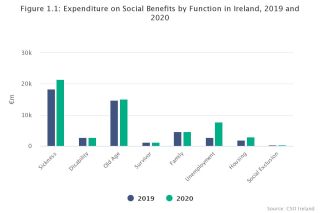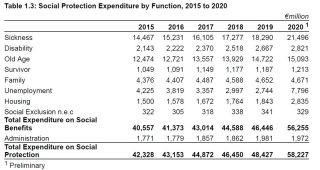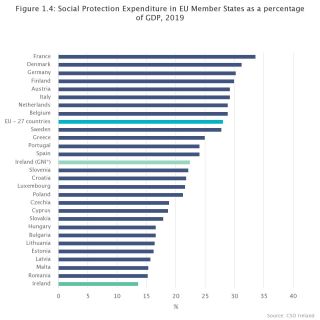Social Protection Expenditure in Ireland 2020

Social Protection Expenditure in Ireland increased by 20% between 2019 and 2020 according to the latest CSO data. Social protection expenditure was €58.2 billion in 2020, a rise of €9.8bn (20%) on 2019, which reflects increased government expenditure on social protection due to the COVID-19 pandemic. Notably, expenditure on unemployment almost trebled from €2.7bn in 2019 to €7.8bn in 2020.
The CSO defines social protection expenditure as a set of interventions where the objective is to reduce social and economic risk and vulnerability, and to alleviate extreme poverty and deprivation. Social protection is typically grouped into eight categories: sickness/healthcare, disability, old age, survivors, family/children, unemployment, housing and social exclusion.
Main findings:
- In 2020, €58.2 billion was spent on social protection in Ireland, a 20% increase on the 2019 spend of €48.4 billion
- The largest areas of expenditure were in sickness/healthcare (€21.5 billion) and old age (€15.1 billion), both of which accounted for 65% of the total spend
- Comparing 2020 with 2019, expenditure on unemployment almost trebled, from €2.7 billion to €7.8 billion due to the impact of the COVID-19 pandemic on social protection expenditure
- Social protection expenditure in 2020 accounted for 16% of Gross Domestic Product (GDP) or 28% of Modified Gross National Income (GNI*)
- Ireland spent €9,815 per person on social protection in 2019, which is above the EU average of €8,769 per person

This chart details the changes in social protection expenditure between 2019 and 2020. The first thing to note is the increase in expenditure on unemployment. Spending on unemployment had dropped in recent years to stand at 6% of total social protection expenditure in 2019, but rose in 2020 to 14% due to COVID-19. The pandemic is also linked to the strong growth in expenditure on sickness between 2019 and 2020, which rose from €18.3bn to €21.5bn or by 17.5%.
In general, expenditure on sickness and old age have consistently accounted for the highest proportion of social protection in expenditure in Ireland as detailed in the table below.

European comparisons
When compared with our European neighbours, Ireland’s social protection expenditure as a percentage of Gross Domestic Product (GDP) is the lowest in the EU at 14%. France has the highest percentage at 34%. However, when expenditure is expressed as a percentage of GNI*, a measure to exclude the globalisation effects in the Irish economy, Ireland moves up to 13th place at 22%. Average expenditure in the EU on social protection was €8,769 per person in 2019. The lowest average was in Bulgaria at €1,460 while the highest was in Luxembourg at €22,172. Ireland spent €9,815 per person in 2019, above the EU average.

The importance of social protection
There is comprehensive research to show that the social welfare system is the key to reducing poverty in Ireland. Welfare payments target those most in need within Irish society. They also play a central role in alleviating poverty. Without the social welfare system almost four in every ten of the Irish population would have been living in poverty. However, welfare payments reduced the poverty rate by 25 percentage points to 13.2 per cent. Thus, when Budget resources are focused on the welfare system they assist those who need most help. Conversely, when a Budget provides limited resources to the welfare system it undermines the living standards and needs of the weakest in our society.
Two recent studies have highlighted the costs that poverty imposes on society and on individuals living in poverty. Social Justice Ireland believes that these are important and relevant insights as the Commission considers the links between taxation, state expenditure and overall societal outcomes.
A report commissioned by the Society of St Vincent DePaul, and authored by Collins, examined The Hidden Cost of Poverty by estimating the public service cost of poverty in Ireland. It identified the additional public service costs that Irish society carries as a result of current and past experiences of poverty. The main estimate presented by the report found that the annual public service cost of poverty to Ireland is almost €4.5bn. Expressed in per capita terms this finding implies that poverty imposes a public service cost equivalent to a sum of €913 per person in the state each year (€2,600 per household). The report also noted that this additional public sector expenditure is equivalent to 5.1% of total General Government Revenue and 5% of total General Government Expenditure. Put another way, €1 in every €20 collected by the state from taxes, social insurance and charges ends up being allocated by the state to make up for the way that poverty damages people’s lives.
Social Justice Ireland welcomes this report, it provides a heretofore absent benchmark for the recurring annual costs to the state of poverty, and highlights for all members of society, whether they are above or below the poverty line, the costs incurred by society as a result of poverty.
A CSO report published in December 2020 examined The Intergenerational Transmission of Disadvantages using data from a module included in the SILC 2019 survey. Based on answers from people aged 25-59 about their life situation when they were about 14 years old, the report explored if a person’s household circumstances as a teenager are associated with poverty indicators in later life. Among its findings, the report highlighted the intergenerational impacts of lower completed education levels as respondents whose parents had lower secondary education had a 16.2 per cent risk of poverty as adults compared with 6.2 per cent for those who had parents with third level education. The CSO report also found that financial disadvantage in childhood appears to persist to adulthood. People who described the financial situation of their teenage home as bad were most likely to be at risk of poverty (18.2 per cent) or living in enforced deprivation (39 per cent) as adults in 2019.
A lesson from past experiences of economic recovery and growth is that the weakest in our society get left behind unless welfare increases keep track with increases elsewhere in the economy. Our social protection system plays a significant role in reducing the risk of poverty, however more can and should be done. As a start Social Justice Ireland believes that benchmarking minimum rates of social welfare payments to movements in average earnings, beginning with the target of 27.5% of average earnings (€222 per week) is therefore an important policy priority.